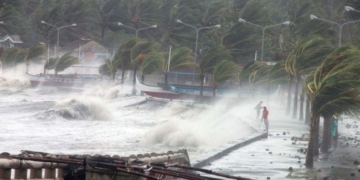For several days, Ho Chi Minh City has maintained temperatures ranging from 38 to over 40 degrees Celsius due to climate change, according to weather expert Le Thi Xuan Lan.
According to Ms. Lan, the temperature reported by meteorological agencies is measured in meteorological shelters. In reality, the temperature felt by people outside is higher, potentially exceeding 40 degrees Celsius in Ho Chi Minh City, especially in construction areas, traffic, and densely populated neighborhoods. “Forecast models from some countries like the U.S. and Europe, which are based on algorithms using data from living environments, indicate that the actual temperatures in Ho Chi Minh City have consistently been above 40 degrees Celsius in recent days,” Ms. Lan said.

Residents of Ho Chi Minh City in hot weather, April 2023. (Photo: Quynh Tran).
Explaining the reasons, Ms. Lan noted that the impact of climate change and the El Nino phenomenon has made weather patterns more extreme. The dry season will be hotter, while the winter will be colder. Events such as hail, tornadoes, lightning, and flooding will occur more frequently and with greater danger.
The Southern Regional Meteorological and Hydrological Center forecasts that the heat is widespread across the southern region. The highest temperature recorded on May 3 was 38.7 degrees Celsius in Bien Hoa, Dong Nai Province.
In Dong Phu (Binh Phuoc), the temperature was 37.3 degrees Celsius, in Thu Dau Mot (Binh Duong) 37.8 degrees Celsius, and in Tay Ninh 37 degrees Celsius.
In the Northwest region and from Thanh Hoa to Phu Yen, temperatures range from 35 to 38 degrees Celsius, with some places exceeding 39 degrees Celsius. In Hanoi, the highest temperature is between 32 and 34 degrees Celsius.
This year’s heat season in the southern region has arrived earlier and lasted longer than in previous years. According to Master Le Dinh Quyet, deputy head of forecasting at the Southern Regional Meteorological and Hydrological Center, the heat is also exacerbated by the foehn effect, making the air not only hot but also very dry, causing discomfort. In Ho Chi Minh City and the southern region, air temperatures remain high, and heatwaves will continue to occur intermittently in May.
According to the Southern Regional Meteorological and Hydrological Center and forecasts from global climate centers, La Nina is transitioning to a neutral phase. This trend is causing temperatures to gradually increase, including average temperatures and daily high and low temperatures.
Associate Professor Dr. Ngo Duc Thanh from Hanoi University of Science and Technology, a scientist involved in the climate change report in Vietnam, shared with reporters that if greenhouse gas emissions continue to rise, temperatures in Vietnam could reach 4.18 ± 1.57°C. As average temperatures rise rapidly, extreme heat events will emerge. “If 35 degrees Celsius was previously considered a high temperature, in the future, it will become the norm with the emergence of new higher temperatures of 40 or 45 degrees Celsius.”

Severe drought may occur in Australia, Indonesia, and several places in South Asia during the El Nino period. (Photo: Outback Australia/Alamy)
In a recent announcement, the United Nations (UN) stated that the likelihood of the El Nino weather phenomenon developing in the coming months is increasing, contributing to a rise in global temperatures and creating new temperature records. The World Meteorological Organization (WMO), part of the UN, estimated on May 3 that the probability of El Nino developing by the end of July is 60% and by the end of September is 80%. “This will change weather and climate patterns around the world,” shared Wilfran Moufouma Okia, director of the regional climate prediction department of WMO, with The Guardian.
El Nino, a natural climate phenomenon typically associated with higher global temperatures, drought in some areas, and heavy rainfall in others, last occurred in 2018 – 2019. Since 2020, the world has experienced an unusually prolonged La Nina period (where sea surface temperatures are cooler than normal, in contrast to El Nino) that ended earlier this year, giving way to the current neutral conditions.
However, the UN warns that the past eight years have been the hottest on record, even though the cooling effect of La Nina lasted for nearly half that time. Without that phenomenon, global warming could have been even more severe. La Nina acted as a temporary brake on the trend of rising global temperatures, according to WMO director Petteri Taalas. He emphasized that the world needs to prepare to deal with the development of El Nino. The expected trajectory of global warming is likely to lead to a spike in global temperatures, threatening to break temperature records.
At this stage, there are no signs regarding the intensity or duration of the upcoming El Nino phenomenon. The most recent El Nino is assessed to be relatively weak, but the previous one from 2014 – 2016 was among the strongest, leading to severe consequences. The WMO rated 2016 as “the hottest year on record due to the combination of a very strong El Nino and human-induced greenhouse warming.” Since the effects of El Nino on global temperatures typically occur in the year following its emergence, the impact is expected to be most pronounced in 2024. The WMO predicts a significant increase in global temperatures over the next two years.


















































